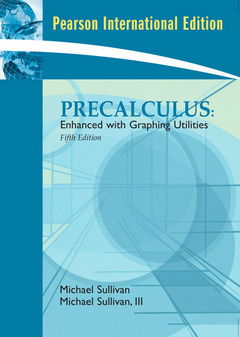Precalculus (5th ed )
Auteurs : SULLIVAN Michael, SULLIVAN Michael

These authors understand what it takes to be successful in mathematics, the skills that students bring to this course, and the way that technology can be used to enhance learning without sacrificing math skills. As a result, they havecreated a textbook with an overall learning system involving preparation, practice, and review to help students get the most out of the time they put into studying. In sum, Sullivan and Sullivan'sPrecalculus: Enhanced with Graphing Utilities gives students a model for success in mathematics.
This is just the standalone book.
Chapter 1 Graphs
1.1 Rectangular Coordinates Graphing Utilities Introduction to Graphing Equations
1.2 Intercepts Symmetry Graphing Key Equations
1.3 Solving Equations Using a Graphing Utility
1.4 Lines
1.5 Circles
Chapter 2 Functions and Their Graphs
2.1 Functions
2.2 The Graph of a Function
2.3 Properties of Functions
2.4 Library of Functions Piecewise-defined Functions
2.5 Graphing Techniques: Transformations
2.6 Mathematical Models: Building Functions
Chapter 3 Linear and Quadratic Functions
3.1 Linear Functions, Their Properties, and Linear Models
3.2 Building Linear Models from Data Direct Variation
3.3 Quadratic Functions and Their Properties
3.4 Building Quadratic Models from Verbal Descriptions and Data
3.5 Inequalities Involving Quadratic Functions
Chapter 4 Polynomial and Rational Functions
4.1 Polynomial Functions and Models
4.2 Properties of Rational Functions
4.3 The Graph of a Rational Function
4.4 Polynomial and Rational Inequalities
4.5 The Real Zeros of a Polynomial Function
4.6 Complex Zeros Fundamental Theorem of Algebra
Chapter 5 Exponential and Logarithmic Functions
5.1 Composite Functions
5.2 One-to-One Functions Inverse Functions
5.3 Exponential Functions
5.4 Logarithmic Functions
5.5 Properties of Logarithms
5.6 Logarithmic and Exponential Equations
5.7 Financial Models
5.8 Exponential Growth and Decay Models Newton's Law Logistic Growth and Decay Models
5.9 Building Exponential, Logarithmic, and Logistic Models from Data
Chapter 6 Trigonometric Functions
6.1 Angles and Their Measure
6.2 Trigonometric Functions: Unit Circle Approach
6.3 Properties of the Trigonometric Functions
6.4 Graphs of the Sine and Cosine Functions
6.5 Graphs of the Tangent, Cotangent, Cosecant, and Secant Functions
6.6 Phase Shift Building Sinusoidal Models
Chapter 7 Analytic Trigonometry
7.1 The Inverse Sine, Cosine, and Tangent Functions
7.2 The Inverse Trigonometric Functions (Continued)
7.3 Trigonometric Identities
7.4 Sum and Difference Formulas
7.5 Double-angle and Half-angle Formulas
7.6 Product-to-Sum and Sum-to-Product Formulas
7.7 Trigonometric Equations (I)
7.8 Trigonometric Equations (II)
Chapter 8 Applications of Trigonometric Functions
8.1 Applications Involving Right Triangles
8.2 The Law of Sines
8.3 The Law of Cosines
8.4 Area of a Triangle
8.5 Simple Harmonic Motion Damped Motion Combining Waves
Chapter 9 Polar Coordinates Vectors
9.1 Polar Coordinates
9.2 Polar Equations and Graphs
9.3 The Complex Plane DeMoivre's Theorem
9.4 Vectors
9.5 The Dot Product
9.6 Vectors in Space
9.7 The Cross Product
Chapter 10 Analytic Geometry
10.1 Conics
10.2 The Parabola
10.3 The Ellipse
10.4 The Hyperbola
10.5 Rotation of Axes General Form of a Conic
10.6 Polar Equations of Conics
10.7 Plane Curves and Parametric Equations
Chapter 11 Systems of Equations and Inequalities
11.1 Systems of Linear Equations: Substitution and Elimination
11.2 Systems of Linear Equations: Matrices
11.3 Systems of Linear Equations: Determinants
11.4 Matrix Algebra
11.5 Partial Fraction Decomposition
11.6 Systems of No
Date de parution : 05-2008
Ouvrage de 1200 p.
21.6x27.9 cm



